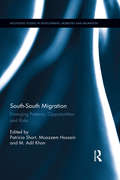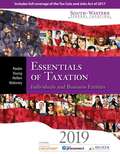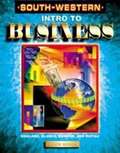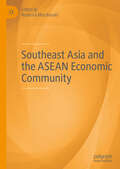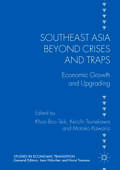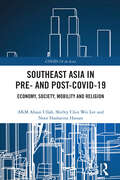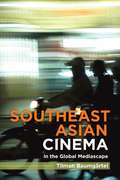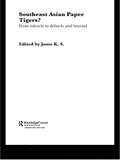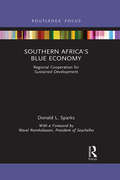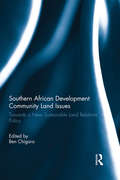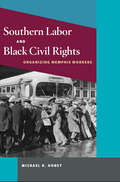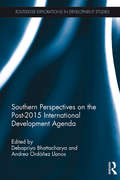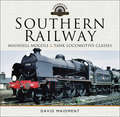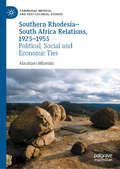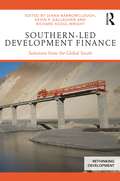- Table View
- List View
South-South Migration: Emerging Patterns, Opportunities and Risks (Routledge Studies in Development, Mobilities and Migration)
by Moazzem Hossain Patricia Short M. Adil KhanSouth-South migration contributes significantly to the development of the emerging economies, the migration of receiving countries and, at the same time, generates a major share of remittance income flowing into the sending countries. By capturing field experience and observations from a number of research studies, this book provides a robust catalogue of data, practical experience and analysis focused on the significant issues, risks and challenges that are associated with this evolving phenomenon in international migration. The book also critically explores new theoretical perspectives by highlighting new policy directions for both sending and receiving countries relevant to making South-South migration more efficient, attractive and mutually beneficial.
South-Western Economics
by J. Holton WilsonCovers every aspect of high school economics, with an emphasis on the importance of economics in personal life as well as in the functioning of domestic and global economies. The four sections include making economic decisions, the microeconomic perspective, the macroeconomic perspective, and the world economy.
South-Western Federal Taxation 2019: Essentials of Taxation: Individuals and Business Entities
by James Young William Raabe Annette Nellen David MaloneyMaster today's most important tax concepts and gain an understanding of the most current tax legislation with SOUTH-WESTERN FEDERAL TAXATION 2019: ESSENTIALS OF TAXATION: INDIVIDUALS AND BUSINESS ENTITIES, 22E. This brief edition's market-leading presentation helps you thoroughly grasp key taxation concepts and applications. You'll find the latest tax legislation at the time of publication, including the Tax Cuts and Jobs Act of 2017. Learning features, such as "Big Picture" examples, tax scenarios and "What If?" cases, clarify concepts and sharpen your critical-thinking, writing skills, and online research skills.
South-Western Federal Taxation 2020: Comprehensive Volume
by William Hoffman James Young William Raabe Annette Nellen David MaloneyMaster today's tax concepts and gain a thorough understanding of current tax legislation with Maloney/Raabe/Young/Nellen/Hoffman's SOUTH-WESTERN FEDERAL TAXATION 2020: COMPREHENSIVE VOLUME, 43E. This complete, understandable book provides today's most effective solution for understanding individual taxation, C corporations, taxes on financial statements and flow-through entities. Updated coverage details the latest tax legislation for both individual taxpayers and corporations, as of the time of publication, including tax reforms of 2018 and the Tax Cuts and Jobs Act of 2017. Engaging learning features, such as Big Picture examples, memorable tax scenarios and What If? case variations help clarify concepts. These features also strengthen critical-thinking, writing and online research skills that are key to your success as a tax practitioner.
South-Western Intro to Business (4th edition)
by Les R. Dlabay James L. Burrow Steven A. Eggland Robert A. RistauIntro to Business 4E allows students to discover how a business works and how it impacts lives on a daily basis. With extended coverage on marketing, management, the Internet, as well as more international business, our new edition provides everything needed to prepare for success in future careers!
South-Western Intro to Business: Activities and Projects, Units 1-6
by James L. Burrow Anne S. Daughtrey Les Dlabay Steven A. Eggland Robert A. RistauThese activities and projects will allow students to master the introductory concepts of business. Each chapter contains a study guide with objective questions and activities that allow students to apply resources, interpersonal skills, and critical thinking skills
South-Western Intro to Business: Activities and Projects, Units 7-12
by James L. Burrow Anne S. Daughtrey Les Dlabay Steven A. Eggland Robert A. RistauThese activities and projects will allow students to master the introductory concepts of business. Each chapter contains a study guide with objective questions and activities that allow students to apply resources, interpersonal skills, and critical thinking skills
SouthPark IV
by William J. Poorvu Richard E. CrumA young entrepreneur examines an 80,000 square foot office/warehouse building as a potential acquisition. The building is currently fully leased but all four leases will expire shortly. Due to changing market conditions, the protagonist has to look at current market conditions as well as trying to estimate future conditions in order to complete his analysis. The case is designed to explore basic issues in real estate valuations. The emphasis is on developing a simple set-up based on the project's cash flows and then examining how returns and values are affected by changing certain assumptions.
Southeast Asia and the ASEAN Economic Community
by Roderick MacdonaldThis book is an introduction to the ASEAN Economic Community (AEC), the economic community founded by Southeast Asian nations. It provides both economic profiles of the member nations and an explanation of the Community itself. This book also discusses the impact of China on the AEC. The book is a starting point for research into the region or into any member country, whether for academic or for business purposes. With over 170 tables and figures as well as an abundance of historical facts, the book offers data-based insights.
Southeast Asia beyond Crises and Traps
by Keiichi Tsunekawa Boo Teik Khoo Motoko KawanoThis book examines five countries in South East Asia that are instructive case studies of how the region has had to negotiate pathways of development beyond crises and traps. At two ends of just one decade, 1997-2007, Indonesia, Malaysia, the Philippines, Thailand and Vietnam all had to weather the shocks of an East Asian financial crisis and a global financial crisis. Some economies might have buckled completely under those shocks and been condemned to long-term stagnation. Yet these five economies, part of the larger Asian region, emerged with continued if slower economic growth. An important theme of this book is that their resilience has been partly derived from the pursuit of growth and competitiveness along less known or recommended pathways. The chapters of this book take a novel approach to South East Asia's search for growth and improvement. They do not begin by evaluating how far macro-level performances would take a particular country towards high-income status. Instead they provide original insights into actual cases of intermediate ways of achieving growth, upgrading and income improvement in non-privileged sectors. Such cases may hold more relevant lessons for the majority of developing countries than the experiences of highly developed economies.
Southeast Asia in Pre- and Post-COVID-19: Economy, Society, Mobility and Religion (COVID-19 in Asia)
by Noor Hasharina Hassan AKM Ahsan Ullah Shirley Chin LeeUllah, Chin, and Hassan provide a comprehensive examination of the transformative impact of the COVID-19 pandemic on Southeast Asia, examining its effects on the region’s economy, social dynamics, mobility patterns and religious practices.The book examines the profound changes and challenges that the region faced, offering insights into both the immediate responses and the long-term adjustments in these key aspects of Southeast Asian life. An in-depth analysis with a comprehensive and up-to-date perspective on the region’s postpandemic landscape offers informed insights into the diverse challenges and opportunities facing Southeast Asia in a rapidly changing world.This book is an essential reading for academics, researchers and policymakers seeking to gain a nuanced understanding of Southeast Asia’s response to the pandemic COVID-19.
Southeast Asian Independent Cinema
by Tilman BaumgartelThe rise of independent cinema in Southeast Asia, and the emergence of a new generation of filmmakers there, is among the most significant recent developments in global cinema. The advent of affordable and easy access to digital technology has empowered new voices from a part of the world rarely heard or seen in international film circles. This book documents these developments as a genuine outcome of the democratization and liberalization of film production of films. Interviewees include Lav Diaz, Amir Muhammad, Apichatpong Weerasethakul, Eric Khoo, Garin Nugroho, Nia Dinata and others.
Southeast Asian Paper Tigers
by Jomo K. S.This important collection is a timely contribution to the debate on the Asian financial crisis. With chapters written by well-established international experts in Asian economics, this book constitutes a finely judged example of the varying opinions on the matter.
Southeast Asian Paper Tigers? (Routledge Studies In The Growth Economies Of Asia #Vol. 46)
by Jomo K. S.This important collection is a timely contribution to the debate on the Asian financial crisis. With chapters written by well-established international experts in Asian economics, this book constitutes a finely judged example of the varying opinions on the matter.
Southeastern Asset Management Challenges Buyout at Dell
by Paul M. Healy Aldo Sesia Suraj SrinivasanIn late 2012, Michael Dell wants to take Dell Inc., the company he founded, private. Mr. Dell believes that the successful company's transformation from a personal computer (PC) manufacturer to an enterprise solutions and services provider (ESS) is dependent on going private without the short-term results scrutiny public companies face. He and a private equity firm, Silver Lake Partners, have made an offer for the company, which Dell Inc.'s board has accepted. The deal requires the vote of a majority of shareholders. Southeastern Asset Management, an investment firm, and Dell Inc.'s second largest shareholder behind Mr. Dell strongly oppose the deal because the offer is well below what Southeastern believes is Dell Inc.'s intrinsic value. Southeastern, along with activist investor Carl Icahn, wage a campaign to defeat the go-private deal and propose a leveraged recapitalization as an alternative. On several occasions it appears that the deal will be voted down by shareholders, but rule changes made by Dell Inc.'s Board eventually pave the way for Mr. Dell to take the eponymous company private-for a price only slightly higher than the original bid. The case describes the reasons why Mr. Dell wants to take Dell Inc. private, why Southeastern and Icahn oppose the deal, the specifics of both the Dell/Silver Lake bid and of Southeastern's/Icahn's leveraged recapitalization proposals, and the events that took place.
Southern Africa's Blue Economy: Regional Cooperation for Sustained Development (Europa Introduction to...)
by Donald L. SparksSouthern Africa’s maritime interests are considerable: its oceans and ports are essential to the wealth of the region, are crucial for trade and are an important source of employment, food and energy. However, regional governments do not place sufficient attention on the Blue Economy and its potential to stimulate economic growth. Of the 17 UN Sustainable Development Goals, goal Number 14 (Life Below Water) is the least funded. Less than 1% of Official Development Assistance goes toward this goal, and even private investment and funding from philanthropic organizations is grossly inadequate to meet Africa’s blue economy needs. It is vital for the international community to face up to the challenges of Africa’s Blue Economy and start working on solutions and for southern Africa’s Blue Economy policies and goals to be expanded. Just as sustainable development green initiatives show promise, so too could Blue Economy projects and activities. Southern Africa’s rich coastal and marine resources need to be managed on both a national and regional level if they are to be used in a long-term, sustainable way. This book provides, for the first time, a concise study of the constraints and opportunities that the Blue Economy offers for southern Africa and the role that the Southern African Development Community (SADC) could play in fostering a sustainable use of its ocean and coastal resources.
Southern African Development Community Land Issues: Towards a New Sustainable Land Relations Policy
by Ben ChigaraThis book constitutes volume one of a two volume examination of development community land issues in Southern Africa. In this volume, Ben Chigara undertakes a holistic inter-disciplinary evaluation of the legitimacy of colonial and emergent post-colonial rule property rights in affected States of the Southern African Development Community (SADC). It particularly focuses on intensifying litigation in national courts, the SADC Tribunal, and more recently the Washington based International Centre for the Settlement of Investment Disputes (ICSID) regarding counter claims to title to property. The book examines cultural, economic and political drivers at the core of SADC land issues, focusing on their significance and potential to contribute to the discovery of a new, sustainable land relations policy that guarantees social justice in the distribution of all the advantages and disadvantages relating to the allocation and use of land. Chigara shows that persistent systematic administrative failures by pre-colonial, colonial and post-colonial authorities have made for a very complex challenge that requires Solomonic tools that neither the Courts alone, nor human rights centric morality alone could resolutely attend. The book recommends a sophisticated systematic new approach to SADC land issues, which is developed in volume two, Re-conceiving Property Rights in the New Millennium. This book will be of great interest to students and researchers of Property and Conveyancing Law, Human Rights Law and Land Law.
Southern China: Industry, Development and Industrial Policy (Routledge Contemporary China Series)
by Marco R. Di Tommaso Lauretta Rubini Elisa BarbieriBy concentrating on one of the key locations of global manufacturing, this volume offers a contribution to contemporary industry studies. The rates of growth that have characterized the southern Guangdong province in the last three decades are unique, even with respect to the more general and often cited Chinese experience. But what role have governments played in these decades of growth? What are the aims and tools of industrial policies promoted in this core location of contemporary manufacturing? And what are the implications of the Guangdong experience of growth for the international debate on contemporary industry? Referencing the international debate on industrial development, specialized Chinese academic literature, official government documents, statistics and in-depth fieldwork this book offers unique view on the complex set of long-term national and local government plans and policies that have gone hand in hand with the last three decades of impressive change in this highly industrialized region. In this framework, local industrial development policy, innovation policy and migration policy are carefully analyzed as three of the main strategic interventions selected by government authorities to promote the desired gradual structural change and technological upgrading in industry. This book will be of interest to students and scholars of Chinese studies, economics and business, development policy and industrial policy. Furthermore, the volume presents stimulating material for both policy makers and entrepreneurs.
Southern Labor and Black Civil Rights: Organizing Memphis Workers (Working Class in American History)
by Michael K. HoneyWidely praised upon publication and now considered a classic study, Southern Labor and Black Civil Rights chronicles the southern industrial union movement from the Great Depression to the Cold War, a history that created the context for the sanitation workers' strike that brought Dr. Martin Luther King, Jr. to Memphis in April 1968. Michael K. Honey documents the dramatic labor battles and sometimes heroic activities of workers and organizers that helped to set the stage for segregation's demise. Winner of the Charles S. Sydnor Award, given by the Southern Historical Association, 1994. Winner of the James A. Rawley Prize given by the Organization of American Historians, 1994. Winner of the Herbert G. Gutman Award for an outstanding book in American social history.
Southern Oregon Timber: The Kenneth Ford Family Legacy (Transportation)
by R. J. GuyerForestry defined the culture of southern Oregon. Kenneth and Hallie Ford rose from humble beginnings with a single sawmill during the Great Depression and helped transform the state's timber industry. They founded one of the largest privately owned wood-products companies in the country, bringing the title "Timber Capital of the Nation" to Roseburg, Oregon. Their legacy remains today through the Ford Family Foundation, dedicated to educational grants and community improvements. Author R.J. Guyer explores the evolution of logging and the challenges faced by the hearty men and women who plied this trade.
Southern Perspectives on the Post-2015 International Development Agenda (Routledge Explorations in Development Studies)
by Debapriya Bhattacharya Andrea Ordóñez LlanosAt the turn of the millennium, the unanimous adoption of the Millennium Development Goals (MDGs) by the United Nations General Assembly marked a new chapter in international development. However, voices from the Global South were noticeably absent in shaping the agenda. Fifteen years later, the global context has changed so much that it would have been inconceivable not to have taken voices from the South into account when planning the new Sustainable Development Goals (SDGs). Since its inception in 2012, the Southern Voice on Post-MDG International Development Goals (Southern Voice), a network of 48 think tanks from Africa, Asia and Latin America, has generated a substantial body of original research to feed into various aspects of the post-2015 development agenda, such as the missing dimensions of the MDGs, ways to mitigate existing challenges in delivering on aspired outcomes, and new issues, goals, targets and indicators that are crucial for the next global development framework. Southern Perspectives on the Post-2015 International Development Agenda consolidates this research and stitches together development realities and policy experiences from the Global South, infusing unique local perspectives to the global debate on the post-2015 agenda. The compendium addresses the overarching themes underpinning the new international development framework by focusing on issues such as sustainability and growth, inclusion and social policies, governance and capacities, and financing of the new agenda. Southern Voice seeks to challenge the "knowledge asymmetry" afflicting the global knowledge system by channelling evidence-based policy analyses produced by centres of excellence, located in the Global South. This is a valuable resource for academics and researchers, policymakers and practitioners, and concerned students in search of alternative views on sustainable development.
Southern Railway: Maunsell Moguls and Tank Locomotive Classes (Locomotive Portfolios Ser.)
by David MaidmentSouthern Maunsell Moguls and Tank Engines is a volume in the series of Locomotive Profiles being published by Pen & Sword. It describes the conception, design and construction of the two- and three-cylinder 2-6-0s initially the ‘Ns’ constructed at the end of the First World War, many at government initiative by the Woolwich Arsenal and their three-cylinder variants, the ‘N1s’. It also describes in similar fashion the class ‘K’ River 2-6-4 tank engines, their riding problems and the decision to convert them as class ‘U’ two-cylinder moguls after the disastrous Sevenoaks derailment in 1927. The solitary ‘K1’ three-cylinder 2-6-4T was similarly converted as the prototype three-cylinder ‘U1’ with new build ‘Us’ and ‘U1s’ following in the early 1930s.The moguls, originally built by Richard Maunsell for the South Eastern & Chatham Railway, became the standard mixed traffic locomotives throughout the Southern Railway for virtually the whole of its existence and many remained until near the end of BR Southern Region’s steam stock in 1965/6.After the experience with the passenger 2-6-4 tank engines, Maunsell restricted his larger tank engine designs to freight work – the class ‘W’ for heavy cross-London interchange freight traffic and the ‘Z’0-8-0T for heavy shunting and banking work. Maunsell also redesigned some elderly LB&SCR E1 0-6-0Ts for branch line work in rural Devon and North Cornwall, providing a radial axle as 0-6-2T class E1/R.The book covers the allocation, operation and performance of these classes and includes some personal reminiscences of the author who experienced the moguls at first hand. It also covers the sale of some of the Woolwich moguls to the CIE in Ireland and the conversion of a number to 2-6-4 freight tank engines for the Metropolitan Railway. The book is lavishly illustrated with over 300 black and white and thirty colour photographs.
Southern Rhodesia–South Africa Relations, 1923–1953: Political, Social and Economic Ties (Cambridge Imperial and Post-Colonial Studies Series)
by Abraham MlomboThis book provides the first comprehensive study of the ‘special relationship’ between Southern Rhodesia and South Africa. While most studies approach this from the history of British and South African relations or the history of South African territorial expansion, this book offers new insights by examining Southern Rhodesia’s relations with South Africa from the former’s perspective. Exploring relations through the lens of settler colonialism, the book argues that settler colonialism in the region was marked by a competitive and antagonistic relationship between settler communities, particularly Afrikaner and English communities. The book explores the connections between these countries by examining (high) politics, economic links, and social and cultural ties, highlighting both instances of competition and cooperation. Above all, it argues that economic ties were the cornerstone of the relationship and that these shaped the rest of the ties between the two countries. Drawing on archival records from Britain, South Africa and Zimbabwe, as well as a number of secondary sources, it offers a much more nuanced perspective of this relationship than has been previously offered.
Southern States Communications
by Constance E. Bagley Michael B. KeatingManagers receiving letters claiming that their products or services violate the intellectual property rights of another sometimes have a tendency to ignore them after their technical staff advises them that the claims have no merit. Illustrates the perils of that approach. Legally astute managers accept responsibility for managing patent disputes; they do not hand them off to lawyers with a "you-take-care-of-it" approach. Litigation is less predictable than many managers realize. A number of choices must be made without full information.
Southern-Led Development Finance: Solutions from the Global South (Rethinking Development)
by Kevin P. Gallagher Diana Barrowclough Richard Kozul-WrightSouthern-Led Development Finance examines some of the innovative new south-south financial arrangements and institutions that have emerged in recent years, as countries from the Global South seek to transform their economies and to shield themselves from global economic turbulence. Even before the Covid-19 crisis, it was clear to many that the global economy needed a reset and a massive increase in public investment. In the last decade southern-owned development banks, infrastructure funds, foreign exchange reserve funds and Sovereign Wealth Funds have doubled the amount of long-term finance available to developing countries. Now, as the world considers what a post-Covid-19 future will look like, it is clear that Southern-led institutions will do much of the heavy lifting. This book brings together insights from theory and practice, incorporating the voices of bankers, policymakers and practitioners alongside international academics. It covers the most significant new initiatives stemming from Asia, tried and tested examples in Latin America and in Africa, and the contribution of advanced economies. Whilst the book highlights the potential for Southern-led initiatives to change the global financial landscape profoundly, it also shows their varied impacts and concludes that more is needed for development than just the technical availability of funds. As governments and businesses become frustrated by the traditional North-dominated mechanisms and international financial system, this book argues that southern-led development finance will play an important role in the search for more inclusive, equitable and sustainable patterns of investment, trade and growth in the post-Covid landscape. It will be of interest to practitioners, policy makers, researchers and students working on development and finance everywhere.
